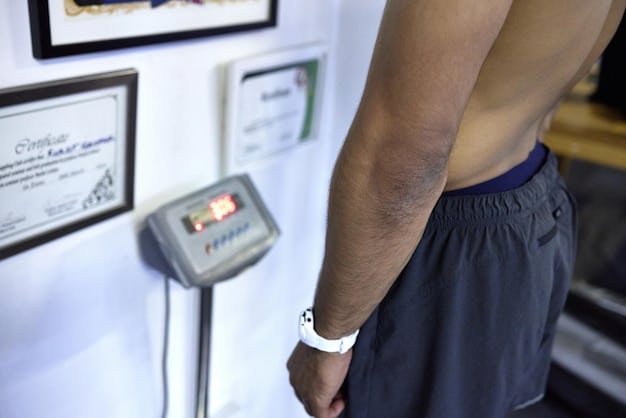The 2025 Guide to Grip Strength: Improve Your Hold & Lift Heavily

Improving grip strength is paramount for athletes and fitness enthusiasts striving to lift heavier, enhance athletic performance, and prevent injuries, requiring targeted training and a nuanced understanding of hand and forearm mechanics.
In the evolving landscape of fitness, the pursuit of strength often focuses on major muscle groups, yet a crucial element, often overlooked, is The 2025 Guide to Grip Strength: How to Improve Your Hold and Lift Heavier. This guide delves into the essence of powerful hands and forearms, exploring why this often-neglected facet of physical prowess is paramount not only for lifting heavier weights but also for everyday functional movements and overall athletic resilience.
The Undeniable Importance of Grip Strength
In the realm of physical performance, grip strength often serves as the silent powerhouse, dictating limits in various lifting exercises and sports. It extends beyond merely holding onto a barbell; it’s about the integral connection between your hands, forearms, and the resistance you’re attempting to overcome. Without a strong grip, even the most powerful back and leg muscles can be rendered ineffective, as the link between you and the weight falters.
Consider the deadlift, for instance. Many athletes find their lifting potential capped not by their back or leg strength, but by their inability to maintain a secure hold on the bar. The same applies to chin-ups, rows, and even everyday tasks like carrying groceries or opening stubborn jars. A robust grip underpins functional strength, contributing significantly to both athletic longevity and an improved quality of life.
Fundamentals of Grip Anatomy: Understanding Your Hold
Before embarking on a training regimen, it’s crucial to understand the intricate network of muscles and tendons responsible for grip. Your grip isn’t a single muscle; it’s a complex interplay of forearm flexors, extensors, and the intrinsic muscles of the hand. The primary muscles include the flexor digitorum profundus and superficialis, which control finger flexion, and the wrist flexors like the flexor carpi radialis and ulnaris.
Beyond isolated strength, the nervous system also plays a vital role. Enhancing neuromuscular efficiency, the ability of your brain to tell your muscles to contract with greater force, is key to unlocking superior grip strength. This involves training the neurological pathways to fire more rapidly and synchronously, leading to a stronger, more stable hold.
- Forearm Flexors: Located on the underside of your forearm, primarily responsible for curling your fingers and wrist.
- Forearm Extensors: On the top side of your forearm, crucial for opening your hand and stabilizing the wrist.
- Intrinsic Hand Muscles: Small muscles within the hand itself, vital for fine motor control and pinching.
- Neuromuscular Efficiency: The brain’s ability to activate muscles more effectively for greater force production.
Understanding these anatomical and neurological components is the first step towards a targeted and effective grip strengthening program. Simply squeezing a stress ball won’t suffice; a comprehensive approach is required to build a grip that genuinely supports heavy lifts and dynamic athletic movements.
The strength of your grip directly influences your capacity to perform under load, making its development a critical component of any well-rounded strength and conditioning program. It translates into safer lifts, improved endurance during sets, and the ability to handle more challenging weights over time.
Assessing and Benchmarking Your Grip Strength
Before you commit to a training program, it’s prudent to establish a baseline for your current grip strength. This not only allows you to track progress effectively but also highlights areas of weakness that may require specific attention. Several methods, from simple self-assessments to more precise dynamometer readings, can help you understand where you stand.
A common and accessible tool is the hand dynamometer, which provides a quantitative measurement of your maximum isometric grip strength. While professional-grade dynamometers are often used in clinical settings, consumer versions are readily available. These devices allow you to squeeze with maximum effort, providing a numerical reading in kilograms or pounds. Regular testing with a dynamometer can offer clear, objective data on your improvement over time.
Practical Home Tests for Grip Assessment
For those without access to a dynamometer, several practical tests can provide a qualitative understanding of your grip capabilities. These tests, while less precise, are excellent for general awareness and identifying significant imbalances.
- Dead Hang Test: Find a pull-up bar and hang from it with an overhand grip for as long as possible. This tests your static hold endurance. Record your time.
- Plate Pinch Test: Place two weight plates together, smooth sides out, and pinch them between your fingers and thumb. Hold them for as long as you can. This assesses your pinch grip strength, crucial for movements like farmers’ carries.
- Farmer’s Carry Test: Grab the heaviest dumbbells or kettlebells you can safely handle and walk for a set distance or time, maintaining a strong grip. This is an excellent functional test of grip endurance and overall core stability.
When performing these tests, it’s important to maintain consistent form and conditions to ensure reliable results. For example, always use the same type of pull-up bar for the dead hang or the same weight plates for the pinch test. Documenting your results is crucial; a simple logbook or smartphone app can track your progress over weeks and months.
Benchmarking your grip strength against norms for your age, gender, and activity level can provide further context. While these norms vary, they can offer a general idea of whether your grip is above, below, or in line with average expectations. However, the most important benchmark is your own progress; focus on improving your personal bests rather than strictly comparing yourself to others.

Consistent assessment helps in customising your training plan, ensuring you are addressing specific weaknesses and celebrating tangible improvements, making your grip training both effective and motivating.
Targeted Training: Exercises to Build a Mighty Grip
Building a powerful grip requires more than just holding onto heavyweights; it demands targeted, progressive training that addresses different facets of grip strength. This includes crushing strength, pinch strength, support grip, and grip endurance. Integrating a variety of exercises into your routine is key to developing a well-rounded and resilient grip.
The foundation of any grip training program should involve exercises that directly challenge your ability to hold, squeeze, and lift. These can be incorporated as dedicated grip sessions or integrated into your existing workout routine, often at the end, when your main lifts are complete.
Key Exercises for Comprehensive Grip Development
Diversifying your grip training to hit all angles is critical for balanced development. Aim to include exercises that challenge different types of grip. For example, exercises like deadlifts primarily train support grip, while plate pinches focus on pinch strength.
- Deadlifts (with no straps): The ultimate test and builder of support grip. Gradually work up to heavier weights without assistance.
- Farmer’s Carries: Grab heavy dumbbells or kettlebells and walk for a set distance. This builds support grip endurance and core stability. Vary the load and distance.
- Plate Pinches: Pinch two or more weight plates together and hold them for time or distance. Excellent for thumb and finger strength.
- Captain of Crush Grippers: These progressive resistance grippers offer a measurable way to build crushing strength. Start with a gripper you can close for repetitions and gradually move to harder ones.
- Fat Gripz / Thick Bar Training: Using fatter barbells, dumbbells, or attachments that thicken existing bars significantly increases the demand on your grip during lifts like rows, pull-ups, and presses.
- Towel Pull-ups/Rows: Throw a towel over a pull-up bar and grip the ends to perform pull-ups or rows. This simulates rope climbing and builds intense grip strength.
Beyond these specific exercises, simply being mindful of your grip during your regular training can enhance its development. For instance, actively squeezing the bar during bench presses or overhead presses can contribute to overall hand and forearm strength. Always prioritize form over excessive weight to prevent injury and maximise muscle activation.
Progressive overload is just as important for grip strength as it is for any other muscle group. This means gradually increasing the resistance, duration, or volume of your grip workouts over time. For example, you might increase the weight on farmer’s carries, hold a dead hang for longer, or move up to a harder gripper.
Remember that consistency is key. Integrating grip work into your routine regularly, even if it’s just a few sets a couple of times a week, will yield significant results over time. Avoid overtraining, as the small muscles of the hands and forearms can also be prone to fatigue and injury.
By incorporating these varied exercises and applying principles of progressive overload, you’ll be well on your way to developing a grip that not only supports heavier lifts but also enhances your athletic capabilities across the board. The resilience and power of strong hands cannot be overstated in achieving peak physical performance.
Integrating Grip Training into Your Routine: Smart Strategies
Successfully integrating grip training doesn’t mean overhauling your entire workout schedule. Instead, it involves strategic placement and thoughtful planning. The goal is to enhance your grip without causing excessive fatigue that might negatively impact your primary lifts or lead to overtraining.
Many athletes choose to incorporate grip work at the end of their main training sessions. This approach ensures that your grip isn’t fatigued when performing heavy compound lifts, which rely on a fresh grip for safety and optimal performance. For example, after your main sets of squats and bench press, you could dedicate 10-15 minutes to specific grip exercises.
Strategic Scheduling and Programming
Consider the frequency and intensity of your grip training. For general strength seekers, 2-3 sessions per week, with adequate rest between, is often sufficient. If you are specifically focusing on grip as a primary goal, you might increase frequency, but always listen to your body and prioritize recovery.
Another effective strategy is to weave grip work into your existing exercises by consciously focusing on a stronger grip. During pull-ups, instead of just hanging, actively squeeze the bar. During deadlifts, avoid straps and concentrate on forging an iron grip. This “active grip” approach strengthens your hands and forearms during compound movements.
- Post-Workout Sessions: Dedicate 10-15 minutes at the end of your regular workout to targeted grip exercises.
- Active Grip During Compound Lifts: Consciously squeeze the bar or handles during exercises like deadlifts, rows, and overhead presses.
- Warm-up Integration: Use light grip exercises as part of your warm-up to activate the forearms and hands, preparing them for heavier lifting.
- Accessory Day Focus: Include more intensive grip work on accessory days, where the overall load on your body is lower.
Varying the grip stimulus is also important. Don’t always stick to the same exercises. Rotate between dynamic movements like farmer’s carries, static holds like dead hangs, and crushing exercises with grippers. This ensures comprehensive development and prevents plateaus.
Pay attention to your recovery. The muscles of the hands and forearms are small and can be easily overtrained. If you experience persistent soreness or decreased performance, it’s a sign that you might need to reduce intensity or frequency, or integrate more rest days. Proper nutrition and hydration also play a crucial role in the recovery process.
Finally, consider progression. Just like any other strength training, grip work demands progressive overload. This could mean increasing the weight you hold, the duration of your holds, or the resistance of your grippers. Continuously challenging your grip is essential for sustained improvement in 2025 and beyond.
By implementing these smart strategies, grip training becomes a seamless, powerful addition to your fitness journey, resulting in noticeably stronger holds and the ability to confidently tackle heavier loads in the gym and in life.
Addressing Common Grip Weaknesses and Overcoming Plateaus
Even with consistent grip training, it’s common to encounter specific weaknesses or frustrating plateaus. Identifying the root cause of these issues is paramount for continued progress. Often, a disproportionate development in one aspect of grip (e.g., strong crushing grip but weak support grip) or insufficient recovery can be culprits.
A common weakness is the thumb. The pinch grip, which relies heavily on thumb strength, is often underdeveloped compared to overall crushing strength. If you find yourself struggling with movements that require pinching or securing an object between your thumb and fingers, dedicated pinch grip exercises should become a priority.
Diagnosing and Resolving Grip Training Challenges
One of the most persistent plateaus revolves around the inability to increase the weight on support grip exercises like deadlifts. This often signals that your forearms are fatiguing before your larger muscles. Introducing dedicated static holds (e.g., holding heavy dumbbells at the top of a deadlift for time) can directly address this endurance deficit.
- Weak Pinch Grip: Focus on plate pinches, using progressively heavier plates or increasing hold time. Also, work with thick-handled dumbbells to simulate pinch-like activation.
- Poor Support Grip Endurance: Incorporate longer farmer’s carries, dead hangs, and static holds at the top of heavy deadlifts or rows.
- Limited Crushing Strength: Regularly use progressive resistance grippers (like Captains of Crush) with a focus on full range of motion. Explore negative holds (slowly opening the gripper) to build eccentric strength.
- Forearm Imbalances: Ensure you’re training both the flexors (for gripping) and extensors (for opening the hand). Wrist curls for flexors and reverse wrist curls for extensors help maintain balance and prevent injury.
Over-training is another frequent cause of plateaus. The small muscles of the forearms and hands require adequate rest to recover and grow. If you’re training grip intensely every day, consider scaling back to 2-3 times a week, allowing for full recovery between sessions. Symptoms of overtraining can include persistent soreness, joint pain, or a decline in performance.

Nutrition and hydration also play a subtle but important role. Adequate protein intake supports muscle repair and growth, while proper hydration ensures optimal muscle function and reduces the risk of cramps. Consider supplements like creatine, which can enhance strength and power, indirectly benefiting grip strength during high-intensity efforts.
When facing a plateau, sometimes a deload week—a period of reduced volume and intensity—can provide the necessary rest for your muscles to recover and then come back stronger. It’s a strategic retreat to facilitate future gains, allowing your central nervous system to reset and muscles to fully repair.
By systematically addressing these common weaknesses and employing intelligent programming strategies, you can effectively overcome plateaus and continue your journey toward superior grip strength. Consistency in identifying and tackling these challenges will lead to remarkable progress and fewer limits in your lifting endeavors.
Advanced Grip Techniques and Tools for 2025
As you progress in your grip strength journey, traditional exercises may eventually need enhancement to provide continued challenge. The year 2025 brings an array of advanced techniques and specialized tools that can push your grip capabilities to new frontiers, demanding greater muscular activation and mental fortitude.
Beyond standard barbells and dumbbells, the landscape of grip training offers innovative equipment designed to isolate and intensify the workout for your hands and forearms. These tools are often employed by powerlifters, strongmen, and competitive grip athletes to break through plateaus and achieve elite levels of strength.
Specialized Equipment and Cutting-Edge Training Principles
One prevalent advanced tool is the rolling thunder handle, which challenges rotational grip strength, often neglected in conventional training. Athletes attach weights to it and perform rows, deadlifts, or carries. The rotating handle forces your grip to stabilize against an unpredictable surface, creating a unique and intense challenge.
- Leverage Bells: These specialized bells, with an extended handle on one side, create a significant leverage challenge for the wrist and forearm, building immense stability strength.
- Pinch Blocks: Designed specifically for pinch grip, these blocks allow for single or multiple finger focus, enabling highly specific training for thumb and digit strength.
- Arm-Wrestling Handles: Replicating the unique grip demands of arm wrestling, these handles are excellent for building crushing strength from various angles and developing powerful pronation and supination.
- Heavy Duty Grippers: Moving beyond entry-level grippers, ultra-heavy-duty models provide extreme resistance, requiring full commitment and precise technique to close.
- Rope Climbing/Thick Rope Pulls: The dynamic and irregular nature of ropes provides an unparalleled grip endurance and strength challenge, engaging the hands and forearms differently than solid bars.
Advanced training principles like “negatives” and “holds to failure” become more prominent. For example, with grippers, performing negatives involves using two hands to close a gripper and then slowly resisting its opening with one hand. This eccentric training builds immense strength and control.
Incorporating static holds with increasingly challenging implements, like thick-handled dumbbells or farmer’s walk handles that are deliberately extra wide, forces maximal isometric contractions to maintain the grip. These are potent for building immense support grip and mental toughness.
Another advanced concept involves manipulating repetition tempo. Slowing down the eccentric (lowering) phase of grip exercises, such as a dead hang, can amplify muscle fiber recruitment and time under tension, leading to greater strength gains. Conversely, explosive contractions, like rapidly opening and closing a gripper, can improve power output.
Embracing these advanced techniques and tools requires a solid foundation in basic grip strength and an understanding of proper form. Integrating them gradually will ensure continued progress, allowing you to not only lift heavier but also enhance your overall functional strength and physical resilience for years to come.
Grip Strength for Injury Prevention and Longevity
Beyond the immediate benefits of lifting heavier and enhanced athletic performance, a strong and resilient grip plays a crucial role in injury prevention and promoting long-term physical health. The hand, wrist, and forearm are intricate structures, prone to various overuse injuries if not adequately strengthened and conditioned.
Many common gym injuries, such as golfer’s elbow (medial epicondylitis) or tennis elbow (lateral epicondylitis), are often linked to imbalances or weaknesses in the forearm muscles. A strong grip, coupled with balanced development of both flexors and extensors, stabilizes the elbow joint and distributes stress more effectively during lifts and daily activities.
Protecting Your Hands and Forearms
Proper grip strength contributes to better biomechanics during lifting. When your grip falters, you often compensate using other muscle groups, leading to altered movement patterns and increased stress on vulnerable joints. For instance, a weak grip during rows might cause you to shrug your shoulders excessively, placing strain on the upper traps and neck.
- Forearm Muscle Balance: Ensure your training addresses both the flexors (for gripping) and extensors (for opening the hand) to prevent imbalances that can lead to elbow and wrist pain.
- Wrist Stability: Strong grip muscles contribute to greater wrist stability, crucial for preventing sprains and strains, especially during overhead movements or heavy presses.
- Improved Joint Health: Regular, progressive grip training can enhance blood flow and nutrient delivery to the tendons and ligaments around the hands and wrists, promoting healthier connective tissues.
- Reduced Risk of Traumatic Injuries: A stronger grip provides better control over implements, reducing the likelihood of dropping weights or losing control during dynamic movements.
- Enhanced Functional Longevity: Maintaining strong hands and forearms is vital for independent living as you age, assisting with daily tasks that require fine motor control and strength.
Grip strength also plays a role in reducing the risk of conditions like carpal tunnel syndrome, which can be exacerbated by repetitive strain without adequate muscular support. By strengthening the surrounding musculature, you create a more protective environment for the median nerve passing through the wrist.
Furthermore, a strong grip is frequently associated with overall health and longevity. Research suggests that grip strength can be an indicator of general muscular strength and even predicts mortality and disability in older adults. Maintaining a strong grip throughout life implies a sustained level of physical activity and muscular resilience.
Incorporating specific warm-ups for your hands and forearms before intense lifting sessions can also aid in injury prevention. Simple wrist rotations, finger stretches, and light gripper squeezes can prime the muscles and joints for the demands ahead, enhancing flexibility and reducing stiffness.
Ultimately, valuing and training your grip strength is an investment in your fitness future. It’s not just about what you can lift today, but how well you can continue to move, perform, and live independently for decades to come, minimizing the impact of injuries and age-related physical decline.
| Key Aspect | Brief Description |
|---|---|
| 💪 Strength Types | Crushing, pinching, support, and endurance are vital for a well-rounded hold. |
| 📊 Assessment | Use dynamometers or dead hangs to track linear progress and identify weaknesses. |
| 🏋️♂️ Key Training | Deadlifts, farmer’s carries, grippers, and thick bar training are foundational. |
| 🩹 Injury Prevention | Balanced forearm training enhances joint stability and reduces common lifting injuries. |
Frequently Asked Questions About Grip Strength
▼
Visible improvements in grip strength can often be noticed within 4-6 weeks of consistent, targeted training. However, significant gains, especially in terms of lifting heavier weights, may take several months. Genetics, training frequency, and adherence to progressive overload play a role. Patience and persistence are key to long-term success.
▼
You don’t need specialized gear to start. Incorporate bodyweight exercises like dead hangs from a pull-up bar, and use towels for pull-ups or rows. Farmer’s carries with heavy dumbbells or kettlebells are highly effective. Simple household items like large books can be used for pinch grip exercises, proving that ingenuity can overcome equipment limitations.
▼
Properly integrated grip training should enhance your main lifts, not hinder them. By improving your hold, you can prevent your grip from being the limiting factor in exercises like deadlifts or rows. It’s best to perform intensive grip work after your main compound lifts to ensure you have fresh hands and forearms for those crucial movements, avoiding pre-fatigue.
▼
Yes, it’s definitely possible to overtrain your grip. The muscles in your hands and forearms are relatively small and used frequently, both in the gym and daily life. Overtraining can lead to persistent soreness, inflammation (like in the elbows or wrists), and decreased performance. Listen to your body and ensure adequate rest, typically training grip 2-3 times per week.
▼
Nutrition significantly impacts muscle recovery and growth, including your grip. A balanced diet rich in protein supports muscle repair, while carbohydrates provide energy for intense workouts. Adequate hydration is also crucial for muscle function. Focus on whole foods, lean proteins, complex carbs, and healthy fats to fuel your training and optimize recovery for stronger grip.
Conclusion
As we navigate the demands of fitness in 2025, the emphasis on robust, functional strength continues to grow. Developing superior grip strength is not merely an accessory to your main lifting endeavors; it is a fundamental component that unlocks enhanced performance, bolsters injury resilience, and profoundly contributes to your overall physical ability. By systematically assessing, training, and strategically integrating grip-specific exercises, you empower your hands and forearms to become the strong foundation upon which heavy lifts and athletic prowess can confidently be built. The journey to a powerful grip is a testament to the fact that true strength is found not just in the largest muscles, but in the intricate command over every fiber of your being.





